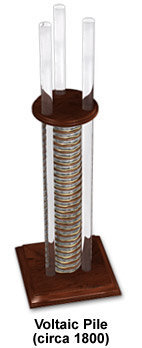3.5.3 Redox Equilibria - Electrochemical cells
Students should:
|
Electrochemical cells
These have been around for a long time as a portable source of energy. We call them batteries. The original batteries were zinc-copper voltaic cells and as technology progressed they moved to zinc - manganese dioxide so called 'dry-cells' and nowadays there are a whole range of different cells including rechargeable nickel and tiny lithium ion cells.
We can divide the electrochemical cells used today into three kinds:
- 1 non-rechargeable
- 2 rechargeable
- 3 fuel cells
These do exactly what it says on the can. The first two kinds are both storage batteries as in they store the chemicals needed to produce electricity within the battery.
Non-rechareable batteries
 A
non-rechargeable battery can be used until it runs out of charge at which time
it is useless and must be disposed.
A
non-rechargeable battery can be used until it runs out of charge at which time
it is useless and must be disposed.
The original experiment done by Alessandro Volta in 1800 used discs of copper and discs of zinc alternating with damp pads between them. He found that by connecting wires to the top and bottom disc and electrical charge passed around the external circuit and that the voltage was proportional to the number of discs used.
He called this device a 'pile' as it was a pile of discs on top of one another. Later the term battery, which means a series of units side by side, came to be introduced.:
It is easy to work out the approximate voltage produced by such a pile.
The electrode potential of Zn2+|Zn(s) = -0.76 V and the electrode potential of Cu2+|Cu = +0.34 V
Therefore the potential difference of a cell made up of one disc of zinc and one of copper should be approximately:
+0.34 - (- 0.76) = +1.10 V
It is approximate because the concentrations of ions produced are not likely to be molar.
The dry cell (EverReady)
These batteries contained a paste of manganese dioxide and ammonium chloride (to provide acidic ions and to complex the zinc ions formed in the reaction) around a carbon rod forming the positive electrode. They were surrounded by a case made out of zinc which was the negative electrode. The two reactions were:
Zn(s) ![]() Zn2+(aq) + 2e
Zn2+(aq) + 2e  Eº = -0.76
V
Eº = -0.76
V
MnO2 + H2O + 1e ![]() MnO(OH) + OH-
MnO(OH) + OH-![]() Eº
= +0.74 V
Eº
= +0.74 V
Hence, before adding the half equations together the second equation must be doubled to equalise the electrons in both. The overall cell reaction is:
Zn(s) + 2MnO2 + H2O
![]() Zn2+(aq)
+ 2MnO(OH) + 2OH-
Zn2+(aq)
+ 2MnO(OH) + 2OH-
This cell, also called a Leclanché cell delivers 1.50 V.
The reactions are actually a little more complex than shown, as the ammonium ions neutralise the hydroxide ions making water and ammonia which complexes the zinc ions.
Rechargeable batteries
A rechargeable battery can undergo many cycles of use - recharge and re-use. Eventually they also reach the end of their lifetimes when they cannot be charged any more. A common example is the lead-acid car battery.
Fuel cells
Fuel cells provide a continuous supply of fuel and will run for as long as supply is maintained. For example the hydrogen - oxygen fuel cell provides a supply of hydrogen gas and oxygen gas to the cell, where it reacts producing electricity.
The hydrogen-oxygen fuel cell.

The hydrogen gas comes into contact with the catalytic platinum surface and the electrolyte where it is oxidised and loses electrons:
H2 ![]() 2H+ + 2e
2H+ + 2e
The hydrogen ions migrate to the cathode (positive electrode) where they assist in the reduction of oxygen gas:
½O2 + 2H+ +
2e ![]() H2O
H2O
The electrons formed at the anode (negative electrode) pass around the external circuit.